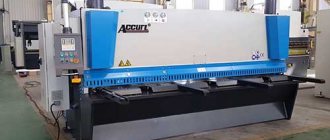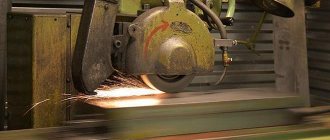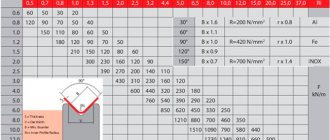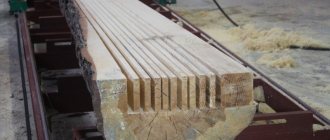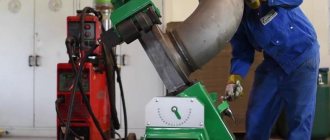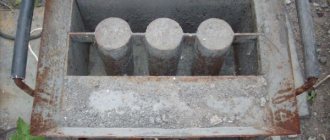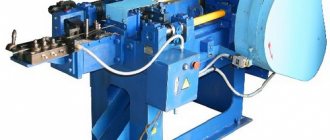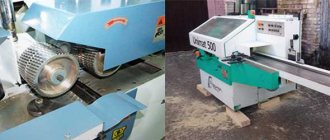Types of shredders
Grinding equipment is divided according to purpose and design.
By purpose:
- Film waste. These units crush polypropylene, acrylic, polyethylene, and polyvinyl chloride films. They are equipped with V-shaped knives that cut the film like many scissors.
- Thin-walled products and bottles. Several cutters installed in series are used. Maximum performance is achieved when the device is fully loaded.
- Large and thick-walled products. Window frames, instrument housings, etc. are crushed.
By design:
Each design group of equipment is designed for grinding its own type of raw material:
- Cheek. Shredding of plastic is carried out by massive steel corrugated plates, between which the plastic is crushed and crushed.
- Hammer. Impact-type devices crush raw materials using hammers hinged on a rotating rotor.
- Conical. The raw materials are crushed between two cones resembling massive graters.
- Rotary. This is the most popular and most versatile type of plastic crusher.
Rotary Disc Shredder
So-called universal units are also used. They simply combine several types of crushers, each of which grinds its own type of waste.
What to look for when choosing a crusher for polymer waste
Despite the fairly simple design, few people manage to create their own grinding machine, comparable in its characteristics to serial samples. The main problem of homemade equipment is its low service life and insufficient reliability. If the company’s plans do not include the development and launch of industrial equipment for shredding plastic on the market, it is wiser to purchase proven solutions.
When choosing a country and a manufacturer’s brand, you should not focus only on the minimum cost and the “Made in Germany/Italy/...” label. Small manufacturers of crushers and shredders often skimp on components, so the service life of the equipment may be less than the warranty period. In reality, equipment from the USA and EU is often produced in China, and is significantly more expensive than similar crushers that do not hide their Chinese origin, all other characteristics being equal.
The main factor that deserves attention is the presence of the selected brand in Russia, the presence of an authorized service center that provides the crusher manufacturer’s warranty and equipment maintenance.
It is important to pay attention to the characteristics of the crusher knives - if they use regular carbon steel, then the cost of sharpening or replacing the knives will exceed the savings from recycling and using plastic. Another important parameter is the noise insulation of the crusher - if the manufacturer has saved on the thickness of the housing, then it will be impossible to be near the device during operation. The ultra-lightweight design can be a significant disadvantage as it usually means the frame is not very rigid, which can lead to distortion when processing hard plastics.
The material of the inner surface of the hopper is also important - it should be easy to clean and not enter into a chemical reaction with crushed polymers. As a rule, the optimal material in terms of price/quality ratio is stainless steel.
Learn more about the rotary shredder
Rotary plastic crushers demonstrate high productivity and crushing depth. Thin-walled waste is crushed by high-speed devices processing up to 100 liters per hour.
For thick-walled waste, machines with low rotation speed but high torque are used; their power reaches 10 kilowatts. Capacity is limited to 15 liters per hour; they can handle the hardest plastics. Medium and large processing plants typically have both types of rotary shredders. At low speed, solid waste is pre-crushed and then finally crushed using high-speed devices.
The working bodies of such devices are the massive corrugated rotor itself and fixed side knives, numbering from 3 to 7. Raw materials enter the working chamber from the loading hopper and fall between the rotor knives and the fixed knives, where they are crushed.
Crusher with built-in shredder-thermocompactor
Rotary shredders are available with one or two rotors. Some models add a grate. It acts like a hammer grinder.
What is the difference between a shredder and a polymer crusher?
Both types of equipment perform the same task - crushing.
When processing plastics, this process is usually divided into two stages :
- coarse grinding - shredders are used for this;
- obtaining fine crumbs - a crusher is used for this.
The operating principle and kinematics of both units are most often the same, and they differ only in some details, for example, the size of the sieve cell, the overlap of the knives and the configuration of the cutting edges.
The process is divided into two stages in order to increase productivity and optimize energy costs.
Operating principle of plastic crushers and scope of application
The operating principle of all crushers is similar. It consists of destroying the source material mechanically. They cause irreversible deformations in raw materials - stretching, shearing, twisting. For crushing, both sharp metal parts of equipment and large particles of raw materials that have not yet been crushed are used.
For each type of raw material, taking into account its mechanical properties, appropriate equipment is selected. For example, it makes no sense to crush the film, but it is easy to cut. And polystyrene waste is useless to cut, but, due to its fragility, it is easy to crush.
In industrial installations, water is used to reduce noise and constantly clean working parts.
The main areas in which plastic shredders are used are:
- procurement workshops of plastics production enterprises;
- factories recycling recyclable materials;
- collection points and primary processing of recyclable materials.
Drive design
In factory crushing plants, two methods are used to transmit rotation from the motor to the gearbox:
- Direct drive (via clutch). Torque transmission occurs without loss, the design is compact in size. If you manage to select a ready-made geared motor, the dimensions and weight of the installation will be even smaller. However, in this case, it is necessary to provide for manual (and ideally automatic) reversing in case of jamming of the rotors.
- Belting . Efficiency losses and relatively high dimensions are compensated by the smooth start of the mechanism. If the shredder becomes jammed, the only risk is that the belt will break or slip.
The transmission of rotation between the rotors (in the case of using one engine) is most often carried out through an open gear drive. When designing, you need to be prepared to calculate it. Most likely, gears will have to be ordered .
We make the crusher ourselves
Industrial crushers have excellent performance and appearance, but are not cheap. In the meantime, you can make a plastic shredder with your own hands; for this you will need a home workshop and plumbing and welding skills.
Materials and tools
To make a device with your own hands you will need:
- Circular saws - 20 pieces. The discs must be free of cracks and not bent. It is better to choose them with different shapes and numbers of teeth - this will expand the capabilities of the device.
- Electric motor.
- Working shaft.
- Two bearings.
- Two pulleys.
- Drive belt.
- Steel angle or other profile for the frame and frame.
- Fasteners
- Steel sheet 0.8-1.5 mm.
- wires, switch and junction box.
Manufacturing procedure
- Assemble the cutting unit. Circular saw blades are placed on the axle, separating them with thick washers or nuts.
- Attach the pulley and bearings to the axle.
- Weld a support frame and a vertical frame from the profile.
- Cover the frame with steel sheet, providing holes for the working shaft.
- Install the cutting unit, securing the bearings in the provided mounts.
- Install the electric motor on the frame, attach the second pulley to its shaft, and adjust the tension of the drive belt.
- Connect the wires in accordance with the electrical diagram, carefully insulating the connections.
Homemade plastic crusher
A homemade plastic crusher is ready to receive raw materials.
Recommendations from experts
Before drilling the first hole, it is necessary to make a detailed drawing of the future unit. Design study will save you from inaccuracies, size discrepancies and many numerical alterations.
Having minimal technical documentation for your device, you can also save a lot of time when it comes time to improve or modify it.
At the design stage, you should also decide on the power of the electric motor. If you are planning large volumes of work and a full load, then you need a more powerful engine. If the unit will operate sporadically, as waste accumulates, then you can choose a low-power one and save on electricity.
In order not to collect plastic crumbs from the floor, it is worth providing a place for a container or a device for attaching a bag under the outlet hole.
Where can I get the drawings?
You need to understand that manufacturers of equipment for shredders and crushers will not make drawings publicly available .
The easiest way to get diagrams for a homemade shredder or crusher is in two ways:
- Read forums on the topic , like this one. The likelihood of finding accurate and detailed drawings of plastic shredders is very low. Often, resource users recycle some unclaimed equipment from a related industry, for example, a lopper. And if a crusher is made from scratch, few people care about documenting all stages of production. Nevertheless, it’s worth reading the forums: analyzing discussions and other people’s design mistakes will help you make a more advanced plastic shredder with your own hands.
- Take measurements from the existing shredder. It will not be possible to obtain complete information, since the owner will not allow you to disassemble a working machine. But even a visual assessment will help in making your own homemade crusher.
Many attempts to make a crusher on their own reach a dead end due to the fact that the designer tries to attach to an existing unit . For example, “fit” all the elements to a worm gearbox found in the garage.
An attempt to reduce the cost of a design using secondary parts, as a rule, leads to mistakes.
Recommendations for self-design
The main task of creating a crusher with your own hands is to save money relative to purchasing a ready-made crusher. To save money, it is necessary to use improvised means during assembly.
The use of new ones is not recommended, because in the event of design or assembly errors, these elements will be damaged. After assembly, it is necessary to check the functionality of the device and its resistance to vibrations at idle. Making your own plastic crusher is only suitable for those who know how to work with tools and have basic knowledge in the field of materials science and drawing.
Required tools and materials
To assemble the chopper, you will need metalworking, welding and grinding tools: drill, file, grinder. Welding joints are usually used to connect the frame and body, and bolted joints are used to attach the engine and cutting part. The materials you will need are metal elements:
- sheets;
- corners;
- stripes;
- pipes and profiles;
- hardware: bearings, bolts, pulleys, coupling (the list depends on the design).
A bucket or tank with solid walls is suitable for the storage tank to prevent the loss of fine particles. The rotary motor is connected to the shaft using a drive, and knives or circular saws are placed on the axis.
Manufacturing process
After preparing everything you need for work , you can begin the first stage of creation. First, a cutting block is created by sliding a circular saw blade onto a pre-prepared axle. To ensure that the required space remains between these improvised knives, it is worth using nuts.
Next, we mount the product on the pulley and, using the bearings, create free rotation. Then we make a rectangular frame and a strong frame from the prepared metal materials.
The second step is to weld the legs, selected in height, using welding. Next, the frame is covered with a sheet of steel; to do this, we attach it to the frame. We create a hole of the required size in it and fix the engine at an equal distance from the cutting parts. A special casing and container for supplying raw materials will be needed for the safety and efficiency of the work process.
After making the frame, we will begin the final stage of assembling the plastic crusher. To do this, we put a special protective casing on the knives and a hopper through which the material will be supplied. When changing the casing, it is worthwhile to provide a hole in it in advance for attaching an axle with a pulley.
The last step is to connect the cutting unit to the motor shaft using a belt. That's it, the design is done.
